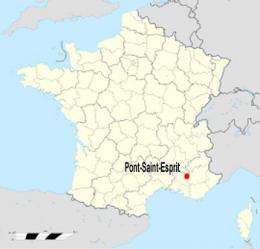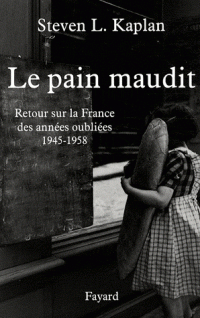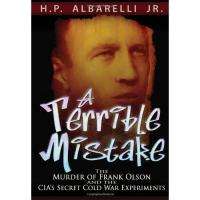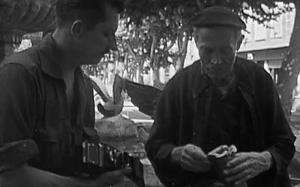March 19, 2010 report
The Mystery Of Cursed Bread & A CIA Agent's Death

(PhysOrg.com) -- For 60 years, the French village of Pont-Saint-Esprit has been famous for the events of a few days in August, 1951, when dozens of villagers were struck with unexplainable and horrifying hallucinations of fire and snakes and beasts of all kinds.
One villager tried to drown himself because he saw his “belly was being eaten by snakes.” Another jumped from a second-floor window screaming, “I am a plane.” A young boy tried to strangle his grandmother. Seventeen people died from what was assumed to be some kind of curse on the village bread (Le Pain Maudit). Many others were sent to asylums.
In the video below, Le mystére du pain maudit, a man with delirium is being stilled, and a survivor of the cursed bread talks about the horror of his hallucination that snakes were coming after him. He says that he would rather have died than to experience that episode. And a descendant of the accused bakery owner walks through the bakery cellars many years after the horror of Pont-Saint-Esprit, claiming she could find no evidence of poisoned bread.
In 2008, a distinguished French historian, author Steven L. Kaplan published an 1,124-page history of bread in France, starting with the middle ages. But the real focus of his book, and indeed the title, is Le pain maudit: Retour sur la France des années oubliées 1945 - 1958. (Cursed bread: Returning to the forgotten years in France 1945 - 1958) Though Kaplan spends the first half of his book on the history of bread, and indeed the food industry in France, he’s just preparing the reader for what happens to the bread in Pont-Saint-Esprit.

Like a great crime writer, Kaplan sets the historical, cultural, and psychological scene, so that a poisoned bread could enter the scene and not be detected. Then, in minute detail, he tells the story of the “forgotten years,” of the villagers, of those afflicted by unforgettable hallucinations - those who died and who survived - and of the bread and of the investigations of the bread.
Kaplin interviews the survivors, many of whom were institutionalized at the time. He interviews witnesses. Kaplan writes of the many scapegoats of the investigation, people accused of allowing ergot to pass into the rye flour. And finally, when the ergot theory was disproved, the target became a mercury that was found in a pesticide. But mercury was disproved as well.
From its thorough description by food historian Kyri Watson Claflin, Le pain maudit: Retour sur la France des années oubliées 1945 - 1958 sounds like an extremely interesting and well-told story, not just about bread, or poison bread, but about France’s historical relationship to food and how sociological and political factors influenced the food industry. (I just wish there was an English translation of the book!)
Thirty-five years after author Steven Kaplan began his research on the cursed bread, at his book’s end there were no apparent clues as to what caused the mystery of Pont-Saint-Esprit.
Kaplan’s book, you’ll remember was published in 2008. Only a year later, in late 2009, H.P.Albarelli, an American investigative reporter, published A Terrible Mistake: The Murder of Frank Olson and the CIA’s Secret Cold War Experiments.

Albarelli is a seasoned writer about CIA activities. His six-year journey into the investigation of CIA agent Frank Olson’s murder led him to discover the secret of the cursed bread. Olson had been a biochemist working for the Special Operations Division of the CIA who “fell” from a 13th floor window in New York City in 1953, two years after the cursed bread incident.
What Albarelli found among CIA documents that he obtained were transcriptions of a conversation between a CIA agent and an official from a Swiss pharmaceutical company, Sandoz Pharmaceutical (now, a division of Novartis). The transcription mentioned the “secret of Pont-Saint-Esprit,” and that the cursed bread had nothing to do with mold, but with diethylamide, as in lysergic acid diethylamide(LSD). The CIA was sprinkling diethylamide into the food supply, possibly with the knowledge of some French officials.

Albarelli learned that it was Sandoz scientists themselves who concocted the story about ergot contaminating the rye flour that bakers used for the bread of Pont-Saint-Esprit. The story was false, but not that far from the truth, considering the strong relationship between ergot and LSD. (Ergot was found to be responsible for the hallucinations leading to the Salem Witch Trials about 25 years ago.)
Albarelli's book also reveals several other barbaric secrets of CIA covert operations during the period of the 1950s through 1970s. Why were the citizens of Pont-Saint-Esprit singled out as victims of one of the CIA’s horrific mind control experiments? Why was Frank Olson murdered? You'll have to read Albarelli’s book, which is published in English.
More information: Kyri Watson Claflin, review of Le pain maudit: Retour sur la France des années oubliées 1945 - 1958; Telegraph.Co.UK www.telegraph.co.uk/ ; H.P.Albarelli's website www.albarelli.net/bio.html; "LSD" www.chm.bris.ac.uk/motm/lsd/lsd1_text.htm
© 2010 PhysOrg.com
















